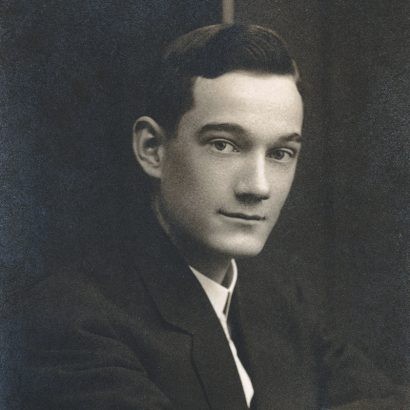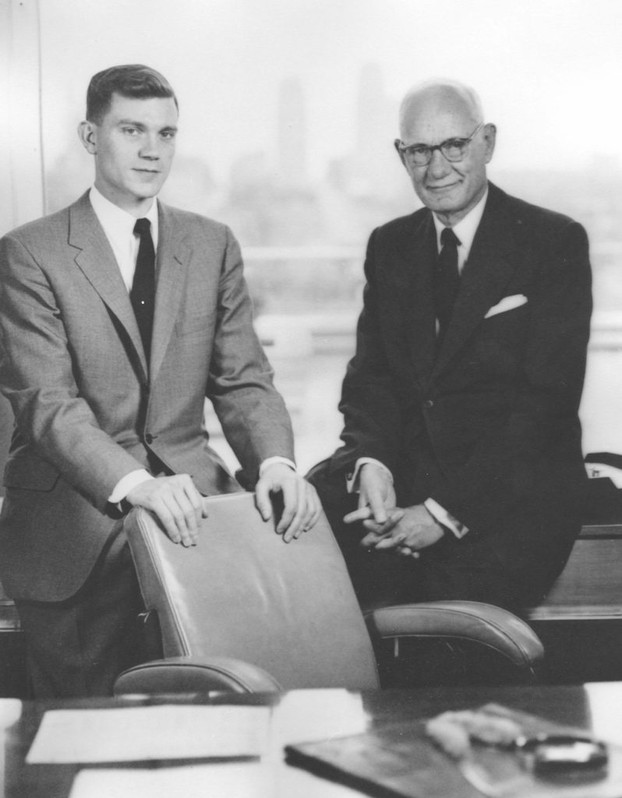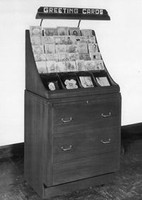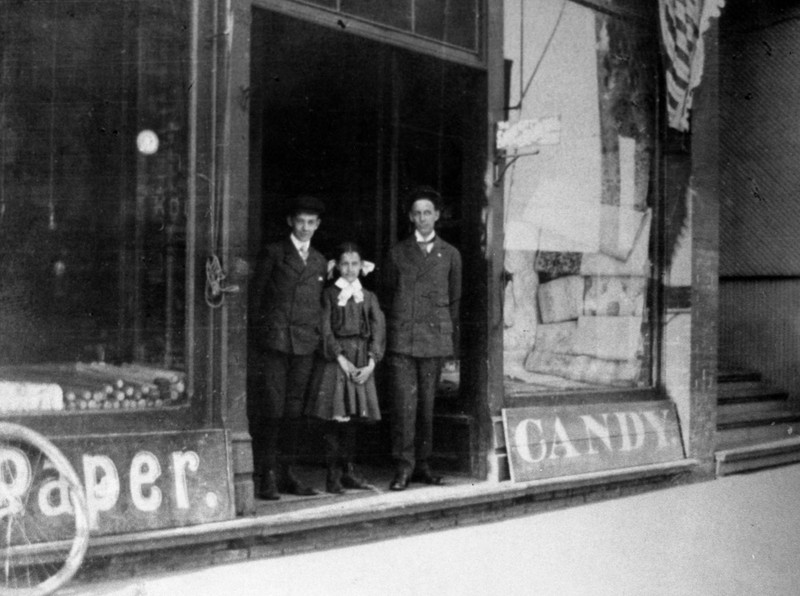Hallmark Cards Corporate Headquarters
Introduction
Author-Uploaded Audio
Hallmark Corporate Archivist and Historian Samantha Bradbeer provides background on Hallmark Cards Corporate Headquarters.
Text-to-speech Audio
Dating back to 1910 and headquartered in Kansas City, Hallmark is the largest and one of the oldest manufacturers of greeting cards in the United States. Founder Joyce Clyde "J.C." Hall began selling postcards for his brother William's bookstore in Norfolk, Nebraska in 1905. Five years later, he moved to Kansas City and opened a specialty store a few years later with his brother Rollie. The siblings named their business called Halls Brothers and offered books, gifts, and postcards, before transitioning to designing and selling greeting cards a couple of years later. Halls Brothers became a national brand in 1928, and while they often used the name "Hallmark Cards," the company name didn’t officially change until 1954. During this period of growth, Hallmark made licensing agreements, built its first headquarters, adopted the crown symbol, and designed the upright greeting card display fixture which is still the standard for cards today. When J.C. retired in 1966, his son Don took over the company and worked with his family to plan Crown Center to revitalize the area surrounding the Hallmark headquarters. Today, Crown Center remains a family friendly entertainment district while Hallmark remains a private, family owned business.
Images
Hallmark Cards was founded in Kansas City, Missouri in 1910 as Halls Brothers.

Hallmark founder Joyce C. "J.C." Hall arrived in Kansas City at the age of 18.

Hallmark has been family owned and operated since its conception as Hall Brothers in 1910.

Hallmark invented the Eye-Vision display, a greeting card fixture concept that is still used today.

An early photo shows employees hand-lettering and coloring Hallmark Cards.

Young Hall siblings stand at the entrance of the book store in Norfolk, Nebraska where Hallmark founder J.C. (left) first sold postcards.

Hallmark logos through the decades.

Backstory and Context
Text-to-speech Audio
Hallmark founder J.C. Hall (1891-1982) first arrived in Kansas City in January 1910 at age 18. J.C. grew up in a poor family in small-town Nebraska, so he and his brothers William and Rollie worked miscellaneous jobs to help with expenses. In 1905 while J.C. was working at the bookstore William was part owner of, a representative of a New York company that sold imported postcards happened to stop in. At that time, the use of postcards was peaking and the gentleman made the Halls a deal they couldn’t pass up. They started wholesaling postcards and called their little business the Norfolk Post Card Company. By 1909, J.C. realized that clientele was limited. With pragmatic advice, he packed up his postcards and entrepreneurial attitude, and set off to capitalize on “the Kansas City spirit.”
When J.C. arrived in Kansas City, he had two shoe boxes full of postcards. He sought out drugstores, bookstores, and gift shops before venturing to surrounding towns along the railroad, and ran the business out of his personal room at the YMCA building. The following year, Rollie, sister Marie, and their mother joined J.C. in Kansas City. At age 29, Rollie was already a veteran salesman. His account contacts, relentless drive, and just as importantly, his seed capital, helped get the fledgling company on its feet and on a course to make history. Rollie would stay with the company as vice president of sales and trusted counselor for his brother J.C. for 43 years, retiring in 1954. While Marie, in addition to caring for their mother, helped showcase the company's product offerings in display cases, and helped her brothers open a specialty store downtown, eventually known as Halls, which offered postcards, books, and gift items. Business was proving successful, but after a 1915 fire destroyed their office, the men were in debt and had no inventory. They pushed forward and bought the Smith-Pierce Engraving Company, who had previously done work for them but was in financial trouble. This was a milestone to their business as they were now also publishers and manufacturers, and as consumers' needs were changing, Halls Brothers improvised. They started producing greeting cards, first offering Christmas cards in 1915 and then Valentines in 1916 that included envelopes to mail. During the holiday season of 1917, Halls Brothers ran out of solid color “gift dressing” for their giftables, so alternatively sold decorative lining from imported French envelopes. With such high demand, they quickly started printing their own gift wrap - which was the beginning of wrapping paper as it’s known today. The war brought a new era of customers and by 1919, greeting cards were becoming a prominent form of communication.
In the 1920s, business was growing faster than ever. Halls Brothers became incorporated and built a six-story factory at 26th and Grand in 1923. Another prominent addition bore a familiar name. In 1921, William F. Hall sold his book and stationary business in Norfolk, Nebraska and moved to Kansas City to join the family firm. He took on responsibilities as office manager and treasurer for the growing company (William would stay with the company as vice president and treasurer for 35 years, retiring in 1956). Eleven years after the company opened it doors in Kansas City, the three Hall brothers were together again -- and the rapidly growing company needed every one of them. Within two years, they were using all 26,000 square feet of their factory and had to lease additional space. Intrigued by the idea that goldsmiths used a mark to guarantee their quality, called a “hall mark,” J.C. officially began marketing their cards as “Hallmark'' in the 1920's, although the official name change wouldn’t happen for a couple decades. Halls Brothers went against advice and was the first greeting card company to advertise nationally; first with an ad written by J.C. for Ladies’ Home Journal, then by sponsoring “Tony Won’s Radio Scrapbook,” a conversational radio talk show. However, advertising paid off and Halls Brothers was becoming recognized nation-wide.
Halls Brothers acquired their first licensing agreement in 1931 with Disney Studios out of California. J.C. had known of Walt Disney from years prior when he was living in Kansas City getting his start in animation. This same year, Halls Brothers implemented a new inventory system that gave visibility of sales and allowed businesses to easily reorder. In addition, Halls Brothers invented a new marketing device called Eye-Vision displays, which were vertical shelves that made the cards more visible to customers, in 1935. The innovative industry-first is still used today. As the company continued to grow, Halls Brothers moved their headquarters across the street to its current location in 1936 and in 1943, J.C. and Rollie Hall, along with J.C.’s wife Elizabeth created the Halls Educational Foundation, now known as the Hall Family Foundation, to give back to the community.
As greeting cards were beginning to become an important means of expression, the 1940s and 50s marked a new era of growth and recognition for Halls Brothers. The slogan “When You Care Enough to Send the Very Best '' was created by marketing executive Ed Goodman in 1944 and in 1949 the company symbol changed from a torch and shield to a five-point crown. In a partnership with NBC in 1951, Halls Brothers sponsored the first made-for-TV opera Amahl and the Night Visitors, which was the first of the series of specials that became Hallmark Hall of Fame. The growing company officially changed their name to Hallmark in 1954 and two years later, a second office building was opened at the headquarters. The building -- built into the natural contour of a steep hillside -- was a bold bit of architecture envisioned by J.C. Hall and executed by Welton Becket. A two-level enclosed bridge thirty feet over Kansas City's busy McGee Street connected the new structure with the old Overland Building. On moving day, employees crossed over from an inspiring past to a promising future. The building was comprised of eight stories with each floor having increased square footage as the terrain allowed. A ninth floor with a penthouse for business meetings and guests was later added.
J.C. Hall retired from the company in 1966, but that did not stop his contribution to Kansas City. Together with Hallmark’s new President, his son Donald, they developed an urban revitalization project for the blighted district surrounding their headquarters. They called it Crown Center with inspiration from their brand symbol. In 1969, Don created a traveling exhibit inspired by the joy of his children when they created art with the leftover Hallmark manufacturing materials. He called it Kaleidoscope, and opened its permanent location in Crown Center in 1975. During this time, Hallmark was becoming known globally. An expansion of products began in the 1970s, including the introduction of keepsake ornaments and the rollout of both humorous and culturally inclusive greeting card categories.
On October 29, 1982, Hallmark founder J.C. Hall passed away. In honor of J.C.s entrepreneurial spirit, the Hall family continued the values and beliefs of filling the basic human need of connecting with others - possibly in bigger ways than he could have imagined. Hallmark started to acquire complementary companies to build for their future, which included Binney and Smith, later known as Crayola LLC, and DaySpring, a leading producer of cards in the Christian category. In 1986, the Hallmark Gold Crown program was formalized to build the strength of the Hallmark brand in independently owned stores.
Through the 1990s, Hallmark started offering products to develop a wider consumer base. They launched a website offering news, company information, and e-cards, and created two new lines; Expressions from Hallmark was offered to mass channel retailers called and the Warm Wishes line available for 99 cents at outlet stores. Into the new century, the Hallmark Channel and Hallmark Movies & Mysteries network were established as well as new greeting card lines including Hallmark Signature, Good Mail and Just Because. New keepsake products such as Recordable Storybooks and itty bittys® plush characters were also introduced.
Today, Hallmark remains a private company and is dedicated to creating a more emotionally connected world and making a difference in the lives of others. Hallmark brands are published in 30 languages and available in more than 100 countries worldwide.
Sources
Hall, Joyce C.. Anderson, Curtiss. When You Care Enough. Volume 1. Hallmark Cards, 1979.
History, Hallmark Corporate. Accessed June 1st 2022. https://corporate.hallmark.com/about/hallmark-cards-company/history/.
J.C. Hall, Hallmark Corporate. Accessed June 1st 2022. https://corporate.hallmark.com/about/j-c-hall/.
https://www.visitkc.com/business-detail/hallmark-visitors-center
https://corporate.hallmark.com/about/hallmark-cards-company/history/founding-1910s/
https://www.hallfamilyfoundation.org/history-timeline/
https://www.pinterest.com/pin/162762974005449760/ via Hallmark Corporate
https://corporate.hallmark.com/about/hallmark-cards-company/history/early-innovation-1910s-30s/
https://www.hallfamilyfoundation.org/history-timeline/
Hallmark Corporate
